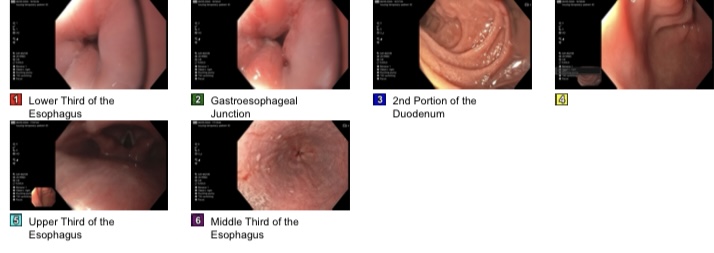Tuesday Poster Session
Category: Esophagus
P4960 - Hidden in Plain Sight: A Rare Case of Primary Non-Barrett’s Esophageal Signet Ring Cell Carcinoma Manifesting as Bilateral Hydronephrosis
Tuesday, October 28, 2025
10:30 AM - 4:00 PM PDT
Location: Exhibit Hall

Mary Ayad, MD (she/her/hers)
Eisenhower Health
Rancho Mirage, CA
Presenting Author(s)
Award: ACG Presidential Poster Award
Mary Ayad, MD1, Artin Asgeri, 2, Mehrdad Asgeri, MD, FACG3
1Eisenhower Health, Rancho Mirage, CA; 2Student, Palm Springs, CA; 3University of California Riverside School of Medicine, Palm Springs, CA
Introduction: Primary signet ring cell adenocarcinoma (SRCA) of the esophagus is an extremely rare and aggressive histologic variant. While most arise in the setting of Barrett’s esophagus, its occurrence without Barrett’s is exceedingly uncommon, with only one previously reported case. SRCA is marked by early submucosal spread and rapid systemic dissemination, often evading detection on routine endoscopy.
We present what we believe to be the second reported case of esophageal SRCA arising in non-Barrett’s mucosa, with initial presentation as bilateral hydronephrosis. This case underscores the importance of high clinical suspicion for malignancy in patients with persistent, unexplained symptoms - even after normal endoscopy.
Case Description/
Methods: A 35-year-old female with a history of fibromyalgia and depression presented with acute bilateral flank pain. Imaging showed severe bilateral hydronephrosis, prompting emergent nephrostomy tube placement. Urologic evaluation showed no stones or obstructing masses. Notably, she reported chronic intermittent abdominal discomfort and weight loss over two years. An EGD and colonoscopy performed one year earlier were unremarkable.
During admission, she reported new-onset dysphagia. Repeat EGD revealed a distal esophageal stricture with benign appearance. However, biopsy confirmed poorly differentiated adenocarcinoma with signet ring cell features. She was diagnosed with stage IV esophageal SRCA.
Discussion: To our knowledge, this represents only the second reported case of pure esophageal SRCA, a rare and diagnostically challenging malignancy. Hydronephrosis was most likely the result of microscopic submucosal invasion and retroperitoneal lymphatic spread; an exceedingly uncommon initial manifestation of esophageal cancer.
Recent years have seen an increase in the incidence of signet ring cell carcinoma of the stomach and gastroesophageal junction; which might be secondary to multistep carcinogenesis involving both genetic and epigenetic alterations.
This case highlights how standard upper endoscopy may fail to early detect infiltrative or subepithelial malignancies, especially when the mucosa appears grossly normal.
Clinicians should maintain a high index of suspicion for occult malignancy in patients with persistent systemic or gastrointestinal symptoms - particularly younger individuals - even in the context of previously negative endoscopic findings. EUS may serve as a critical tool for early detection of infiltrative esophageal lesions.

Figure: EGD
Disclosures:
Mary Ayad indicated no relevant financial relationships.
Artin Asgeri indicated no relevant financial relationships.
Mehrdad Asgeri indicated no relevant financial relationships.
Mary Ayad, MD1, Artin Asgeri, 2, Mehrdad Asgeri, MD, FACG3. P4960 - Hidden in Plain Sight: A Rare Case of Primary Non-Barrett’s Esophageal Signet Ring Cell Carcinoma Manifesting as Bilateral Hydronephrosis, ACG 2025 Annual Scientific Meeting Abstracts. Phoenix, AZ: American College of Gastroenterology.
Mary Ayad, MD1, Artin Asgeri, 2, Mehrdad Asgeri, MD, FACG3
1Eisenhower Health, Rancho Mirage, CA; 2Student, Palm Springs, CA; 3University of California Riverside School of Medicine, Palm Springs, CA
Introduction: Primary signet ring cell adenocarcinoma (SRCA) of the esophagus is an extremely rare and aggressive histologic variant. While most arise in the setting of Barrett’s esophagus, its occurrence without Barrett’s is exceedingly uncommon, with only one previously reported case. SRCA is marked by early submucosal spread and rapid systemic dissemination, often evading detection on routine endoscopy.
We present what we believe to be the second reported case of esophageal SRCA arising in non-Barrett’s mucosa, with initial presentation as bilateral hydronephrosis. This case underscores the importance of high clinical suspicion for malignancy in patients with persistent, unexplained symptoms - even after normal endoscopy.
Case Description/
Methods: A 35-year-old female with a history of fibromyalgia and depression presented with acute bilateral flank pain. Imaging showed severe bilateral hydronephrosis, prompting emergent nephrostomy tube placement. Urologic evaluation showed no stones or obstructing masses. Notably, she reported chronic intermittent abdominal discomfort and weight loss over two years. An EGD and colonoscopy performed one year earlier were unremarkable.
During admission, she reported new-onset dysphagia. Repeat EGD revealed a distal esophageal stricture with benign appearance. However, biopsy confirmed poorly differentiated adenocarcinoma with signet ring cell features. She was diagnosed with stage IV esophageal SRCA.
Discussion: To our knowledge, this represents only the second reported case of pure esophageal SRCA, a rare and diagnostically challenging malignancy. Hydronephrosis was most likely the result of microscopic submucosal invasion and retroperitoneal lymphatic spread; an exceedingly uncommon initial manifestation of esophageal cancer.
Recent years have seen an increase in the incidence of signet ring cell carcinoma of the stomach and gastroesophageal junction; which might be secondary to multistep carcinogenesis involving both genetic and epigenetic alterations.
This case highlights how standard upper endoscopy may fail to early detect infiltrative or subepithelial malignancies, especially when the mucosa appears grossly normal.
Clinicians should maintain a high index of suspicion for occult malignancy in patients with persistent systemic or gastrointestinal symptoms - particularly younger individuals - even in the context of previously negative endoscopic findings. EUS may serve as a critical tool for early detection of infiltrative esophageal lesions.

Figure: EGD
Disclosures:
Mary Ayad indicated no relevant financial relationships.
Artin Asgeri indicated no relevant financial relationships.
Mehrdad Asgeri indicated no relevant financial relationships.
Mary Ayad, MD1, Artin Asgeri, 2, Mehrdad Asgeri, MD, FACG3. P4960 - Hidden in Plain Sight: A Rare Case of Primary Non-Barrett’s Esophageal Signet Ring Cell Carcinoma Manifesting as Bilateral Hydronephrosis, ACG 2025 Annual Scientific Meeting Abstracts. Phoenix, AZ: American College of Gastroenterology.

